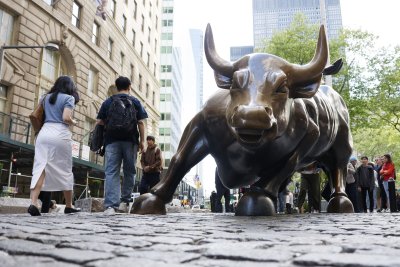
May 7 (UPI) — The Federal Reserve on Wednesday announced the lending rate would hold steady due to economic uncertainty caused by the Trump administration’s tariffs.
The lending rate remains between 4.25% and 4.5% despite President Donald Trump wanting it lowered to offset potential inflation due to his tariffs policy and subsequent global trade wars, The Hill and CNBC reported.
The three major U.S. stock indexes finished the day up less than 1% after the Fed’s decision. Before the announcement, they fluctuated up and down.
Concerns about tariff-related inflation and slower economic growth are behind the Fed’s decision to hold rates steady, despite efforts by President Donald Trump to pressure the Fed for interest rate cuts.
“It’s not a situation where we can be preemptive, because we actually don’t know what the right responses to the data will be until we see more data,” Fed Chairman Jerome Powell told reporters after the announcement.
Despite uncertainly, Powell said “the economy itself is still in solid shape.”
The Federal Open Market Committee said in a statement: “The unemployment rate has stabilized at a low level in recent months, and labor market conditions remain solid” but “inflation remains somewhat elevated.
“The committee seeks to achieve maximum employment and inflation at the rate of 2% over the longer run,” the statement said. “Uncertainty about the economic outlook has increased further.”
U.S. negotiations with key trade partners could impact the economic outlook, Powell said.
As tariffs exert higher inflationary pressure, the Fed is unlikely to cut interest rates again soon unless the job market takes a hit. They last lowered the funds rate in December by 25 basis points.
The Fed wants to cut inflation but also must balance that goal against the risks of tipping the economy into recession.
“The Fed’s got to wait for two things: It’s to see that the policy actually goes into place … But then, when it’s demonstrated, it’s got to see how inflation expectations react. So that’s why the Fed’s got to delay, then go slow,” BNY Investments chief economist and former Fed official Vincent Reinhart said in a statement.
BNY still expects two interest rate cuts in 2025.
“The level of the tariff increases announced so far is significantly larger than anticipated. The same is likely to be true of the economic effects, which will include higher inflation and slower growth,” Powell said in April.
Trump called for Powell’s firing after that statement.
On top of the tariffs, the economy contracted in the first quarter of 2025 as gross domestic product fell by 0.3% at an annual rate.
Consumer sentiment at the end of April plunged to the lowest level since May 2020 during the COVID-19 pandemic.
The Fed has been managing interest rates to curb inflation without sending the economy into recession with the goal of returning inflation to 2%.
The current economic climate is posing a challenge to Fed policymakers as they try to read the data to determine future interest rate decisions.
Goldman Sachs economist David Mericle said in a note it could take a couple of months for enough data to come in to “make the case for a cut.”
Most trading partners now have a baseline 10% tariff enacted on April 5. Trump paused retaliatory tariffs for the worst offenders for 90 days until July 9, including 26% against India, 25% against South Korea, 24% against Japan and 20% against the 27 members of the European Union. Trump’s 145% tariff against China remains in place though he later excluded electronics.
On Wednesday night, Trump posted on Truth Social: “Big News Conference tomorrow morning at 10:00 A.M., The Oval Office, concerning a MAJOR TRADE DEAL WITH REPRESENTATIVES OF A BIG, AND HIGHLY RESPECTED, COUNTRY. THE FIRST OF MANY!!!”
Stock markets
The Dow Jones Industrial Average rose 284.97 points, or 0.7%, to 41,113.97. The record was 45,014 on Dec.4 but had dropped to 37,645.59 on April 8.
The Standard and Poor’s 500 climbed 24.37 points, or 0.43%, to 5,631,28, which is off the record of 6,144.15 on Feb. 19 then dropped to 4,982.77 on April 8.
The tech-heavy Nasdaq Composite increased 48.5 points, or 0.27%. The index went into a bear market on April 4 for the first time since 2022 and further dropped to 15,267.913 on April 8. The record high was 20,173.89 on Dec. 16.
Of the 11 CNBC sectors, eight increased, led by consumer discretionary at 1.02% and health at 0.81%. The biggest decline was communications services at 1.84%.
The price of one ounce of gold was up $25.20 to 3,416.7, just off the record 3,425.30 on April 25.
A barrel of oil has been at the lowest level since 2021. On Wednesday, West Texas Intermediate Crude was $58.45, a 39-cent increase. On Monday, it was $57.13, the cheapest since January 2021.
The yield on the 10-year Treasury note ticked up 0.014 to 4.285%.